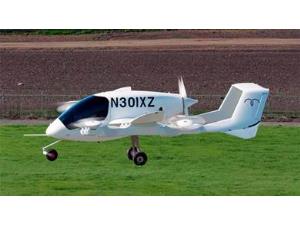



Date:06/02/20
 Air mobility company Wisk has signed an agreement with the New Zealand government to set up and run an air taxi trial in the region of Canterbury, with the goal of flying passengers once its Cora aircraft is certified to do so by the country’s aviation authority. Cora is an electric vertical takeoff and landing (eVTOL) aircraft with space for two passengers that works primarily autonomously, with a remote pilot as backup.
Air mobility company Wisk has signed an agreement with the New Zealand government to set up and run an air taxi trial in the region of Canterbury, with the goal of flying passengers once its Cora aircraft is certified to do so by the country’s aviation authority. Cora is an electric vertical takeoff and landing (eVTOL) aircraft with space for two passengers that works primarily autonomously, with a remote pilot as backup.
Cora was originally a project developed by Sebastian Thrun’s Kitty Hawk, which it revealed in 2018, and actually began testing quietly in New Zealand in 2017 with an eye toward eventual certification. Kitty Hawk partnered with Boeing on the project, and ultimately the two formed a more formal joint venture that became Wisk, while Kitty Hawk shifted focus to its Heaviside land-anywhere electric vehicle.
The aircraft features a 12-rotor flight system, which provides redundancy and vertical lifts, with one large fixed prop that kicks in post-take off to propel it around 100 miles per hour through the air. It’s definitely designed for short hops, with a range of around 25 miles initially, but the point is that it’s for getting around more flexibly in urban and more densely developed areas, replacing cars and other forms of ground transportation.
If this trial gets underway relatively quickly, it’ll be the first major initiative of its kind active in the world, which would be a significant step toward commercial short-hop air taxi service and definitely something closely watched by the rest of the aviation and mobility industry.
Wisk signs deal to deploy an air taxi trial in New Zealand
 Air mobility company Wisk has signed an agreement with the New Zealand government to set up and run an air taxi trial in the region of Canterbury, with the goal of flying passengers once its Cora aircraft is certified to do so by the country’s aviation authority. Cora is an electric vertical takeoff and landing (eVTOL) aircraft with space for two passengers that works primarily autonomously, with a remote pilot as backup.
Air mobility company Wisk has signed an agreement with the New Zealand government to set up and run an air taxi trial in the region of Canterbury, with the goal of flying passengers once its Cora aircraft is certified to do so by the country’s aviation authority. Cora is an electric vertical takeoff and landing (eVTOL) aircraft with space for two passengers that works primarily autonomously, with a remote pilot as backup.Cora was originally a project developed by Sebastian Thrun’s Kitty Hawk, which it revealed in 2018, and actually began testing quietly in New Zealand in 2017 with an eye toward eventual certification. Kitty Hawk partnered with Boeing on the project, and ultimately the two formed a more formal joint venture that became Wisk, while Kitty Hawk shifted focus to its Heaviside land-anywhere electric vehicle.
The aircraft features a 12-rotor flight system, which provides redundancy and vertical lifts, with one large fixed prop that kicks in post-take off to propel it around 100 miles per hour through the air. It’s definitely designed for short hops, with a range of around 25 miles initially, but the point is that it’s for getting around more flexibly in urban and more densely developed areas, replacing cars and other forms of ground transportation.
If this trial gets underway relatively quickly, it’ll be the first major initiative of its kind active in the world, which would be a significant step toward commercial short-hop air taxi service and definitely something closely watched by the rest of the aviation and mobility industry.
Views: 450
©ictnews.az. All rights reserved.Similar news
- Azerbaijani project to monitor disease via mobile phones
- Innovative educational system to be improved under presidential decree
- NTRC prolongs license of two TV and radio organizations for 6 years
- Azerbaijan establishes e-registry for medicines
- Azerbaijani museum introduces e-guide
- Nar Mobile opens “Nar Dunyasi” sales and service center in Siyazan city
- International conference on custom electronic services held in Baku
- OIC secretary general to attend COMSTECH meeting in Baku
- Azerbaijan develops earthquake warning system
- New law to regulate transition to digital broadcasting in Azerbaijan
- Azerbaijani State Social Protection Fund introduces electronic digital signature
- Intellectual traffic management system in Baku to be commissioned in December
- Tax Ministry of Azerbaijan started receiving video-addresses
- World Bank recommends Azerbaijan to speed up e-service introduction in real estate
- Azerbaijan to shift to electronic registration of real estate





















